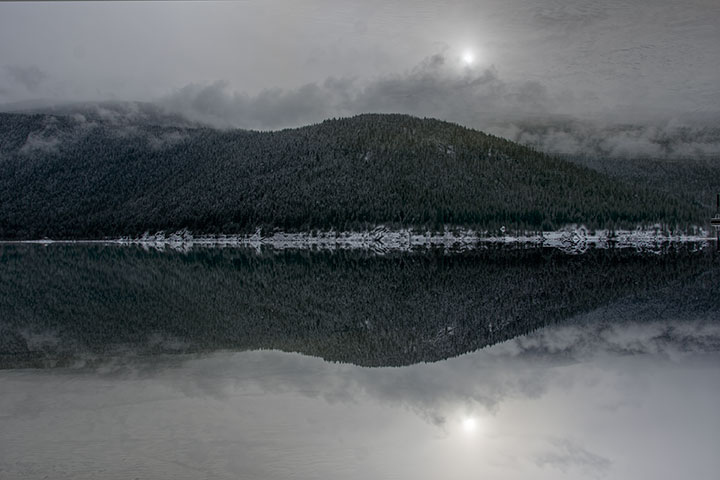Yestermorn’s simple view of the Lake may constitute one of the oddest versions of a scene I have posted. I will explain that below. First, there is the story of why I took the picture.
About a decade ago, I began reading about water, waves, and beach formation. There were endless insights obtained into wave formation, reflection, and diffraction, followed by those of sand erosion, sorting, and longshore drift. Most of this helped me to understand the interesting behaviour and appearance of the beaches around Kootenay Lake.
Yet, one portion of the reading made no sense to me. I learned about the winter storms that eroded beaches and steepened the transition to the backshore. I soon realized that the writers dealt exclusively with the majority of the world’s beaches: those around oceans or lakes having little surrounding relief. There the winter winds build waves that pound and erode the shoreline; this just does not happen around here.
Kootenay Lake lies in a deep mountain valley. To a good extent, the winds of winter storms roar across the mountain tops without penetrating valley bottoms. Valley winter is often a time of tranquility. It is the downdraughts from summer thunderstorms that rake the valley bottoms with winds that generate the biggest waves.
How does one represent the tranquility of winter in a single picture? Can one do so with a picture showing a simple reflection in the Lake? Well, sort of. The trouble is that we are so used to seeing even a moderately good reflected image that has been dragged out by ripples that we readily accept minor departures from a perfect reflection. So, how could I show that the shapes in this morning’s scene were virtually the same either way up?
I will explain what appears in this image without explaining how it was created. First, this is a single picture (one click of the camera). Second, the left quarter of picture is normal and the right quarter is upside down. The central half is a gradual transition (one pixel at a time) from being normal to being upside down.
The plausibility of this picture is a measure of the tranquility of winters around the Lake.
This picture transitions from being correct (left) to upside down (right), yet it appears natural.

I’m curious how you did this from a technical perspective. Is there I commercial product that allows this type of vertical swapping or did you write your own code?. Also, I so see if it’s possible to capture the opposite extreme, i.e. the rougher weather at elevation whilst still showing the calm down below? In any case, nice picture as always.
John, second question first. Yes. Qualifying for such a picture might be those showing: snow blowing off peaks; smoking mountains (not a fire, but a type of cloud); cap clouds (or combinations of them). Now, the first question: More time was spent deciding what I wanted to do than was spent in doing it. Key was a programme that allows the creation of image layers and masks (I used Photoshop). The original picture was duplicated onto a second layer, flipped vertically, and then perfectly aligned with the original (the command, Auto-align layers…). Now a layer mask was attached to the top layer. Where the mask is white, the top image is seen; where the mask is black one sees through to the bottom image; where the mask is shades of grey, there is a mix of the two images. So, the mask had a white quarter, a black quarter and a gradient fill through the middle. The image is flattened and one is done. The final image can be used as is or upside down depending on whether the inverted view is to be shown on the left or right.
Fascinating, Alistair.
Here’s to many more such insights in the year ahead!
Best to you and yours
Trevor